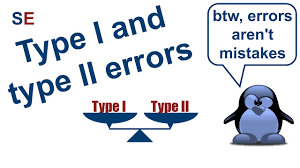I am not interested in knowing the difference between good and bad. I am interested in knowing the difference between good and great: Aaron Sorkin
Introduction
In the novel ‘The Comedy of Error’ by William Shakespeare, two twin characters create mistaken identity and Humour for the readers. In many movies, the twin characters create confusion and comedy. Something similar happens in real life too, when we fail to realize the true character of the person till we face some problem in our life.
Objective
Why we should conduct the Measurement System Analysis (MSA) study? What is the purpose of it? What are the conditions which demand MSA study? Does MSA study serve any purpose?
By understanding and having clarity about Type I and Type II error, we can unravel many answers to them.
Definitions: MSA (Measurement System Analysis) 4th Edition
Bias: The difference between the observed average of measurements and the reference value.
Linearity: The change in bias over the normal operating range.
Stability (Drift): The total variation in the measurement obtained with the measurement system on the same master or parts when measuring a single characteristic over an extended time period. Stability is the change in bias over time.
Repeatability: Variations in the measurements obtained with one measuring instrument when used several times by an appraiser while measuring the identical characteristic on the same part.
Reproducibility: Variation in the average of the measurements made by different appraisers using the same gauge when measuring a characteristic on a part.
Detailed Information
Measurement Systems Analysis is a key step to any process improvement effort. By understanding existing measurement systems, a team can better understand the data provided by those systems and make better business decisions. To understand Measurement System Analysis (MSA) effectively, the understanding of keywords like Type I and Type II error is important. Once we have clarity about it, it becomes easy to decide where and why the MSA study has to be conducted.
In any measurement system, there can be 5 different errors. They are
- Bias
- Repeatability
- Reproducibility
- Stability
- Linearity
The key purpose of conducting the study:
- Whether your measurement system variability is small compared with the process variability.
- Whether your measurement system is capable of distinguishing between different parts.
Measurement error can cause incorrect decision about the product
- Calling a common cause, a special cause
- Calling a special cause, a common cause
Possible Causes of Type I and Type II Error:
- Operator competence
- Variation in the equipment
- Calibration issue
- Measurement fixture inadequate
- Measuring the wrong characteristic
- Environment issue: Temperature, Humidity, Vibration, cleanliness
Key difference between Type I and Type II Error:
| S.No. | Type I | Type II |
| 1 | The good part is sometimes called ‘bad’ | The bad part is sometimes called ‘good’ |
| 2 | False Alarm | Miss Rate |
| 3 | Producer Risk | Consumer Risk |
Example: Type I Error (Producer Risk)
Measurement Error: 0.02 mm
Dimension: 4.90 to 5.00
Actual Dimension: 4.99 mm
Due to Measurement Error, Observed: 5.01 mm.
Result: Product Rejected, although OK
Example: Type II Error (Consumer Risk)
Measurement Error: 0.02 mm
Dimension: 4.90 to 5.00
Actual Dimension: 4.89 mm
Due to Measurement Error, Observed: 4.91 mm.
Result: Product accepted, although Not OK
To maximize the possibility of CORRECT decision for products states, the following are the 2 possible options
- Improve the production process: by reducing the variability of the process so that no parts will be produced in the II area
- Improve the measurement system: by reducing the measurement system error to reduce the size of II areas
Present Challenges:
- How often the organization is clear about the difference between both?
- How often the selection of instrument and appraisee is based on Type I and Type II error?
- How often the decision of the MSA study is based on the context and not only based on the MSA result?
References:
IATF 16949: 2016
MSA 4th Edition (Measurement System Analysis)- AIAG
Industry Experts
This is the 100th article of this Quality Management series. Every weekend, you will find useful information that will make your Management System journey Productive. Please share it with your colleagues too.
Your genuine feedback and response are extremely valuable. Please suggest topics for the coming weeks.
